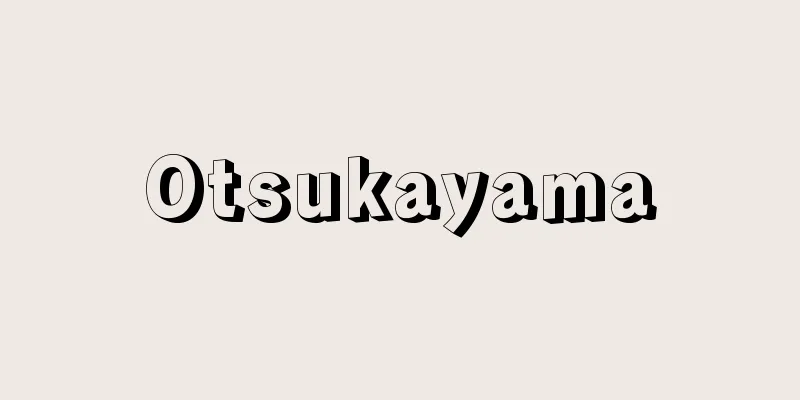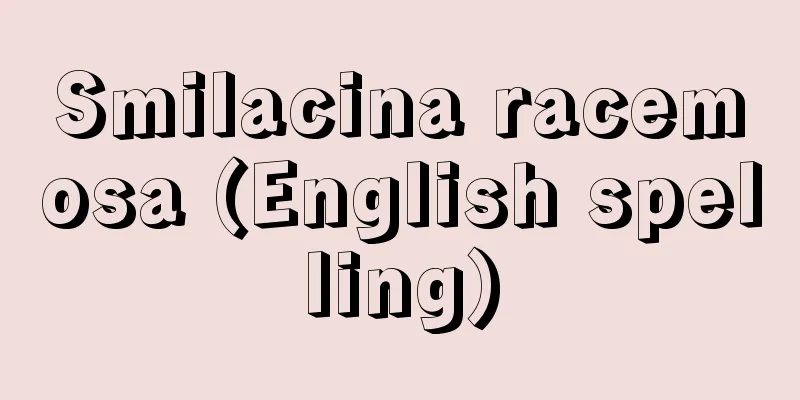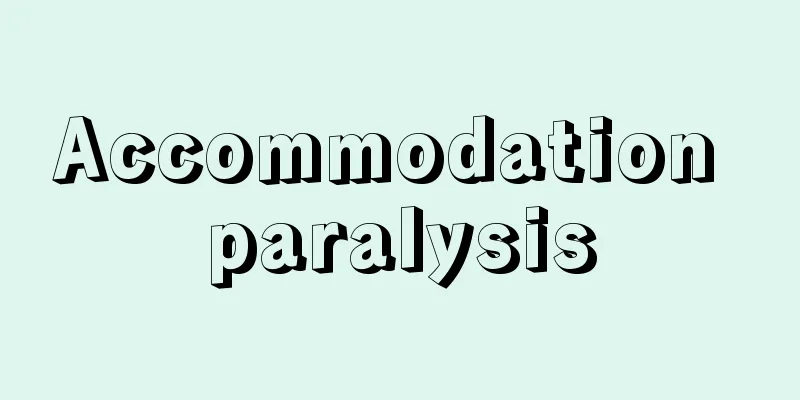Art museum - Bijutsukan

|
An institution that collects and preserves artworks based on academic and specialized research, and exhibits them as necessary, and the building that houses it. In Japan, this work is mainly carried out by specialized staff known as curators. The names and duties of specialized staff vary from country to country, with curators in the United States, keepers in the UK, and conservateurs in France. There are art museums that can be called fine art museums, which display archaeological artifacts, weapons, clothing, and other items in addition to paintings, sculptures, and crafts, as well as art galleries (Pinakothek in German) that only display paintings, and art museums that specialize in sculpture (Glyptothek). In addition, as in the National Gallery of Art in London and Washington, the term "gallery," which originally meant a corridor or passageway, is sometimes used to mean something similar to a picture gallery. [Nao Tomobe] historyWesternThe word "museum" comes from the temple of the Muses, the goddesses of poetry and music in Greek mythology. Around 300 BC, Ptolemy I, who inherited Egypt, displayed paintings and statues in his palace in Alexandria and named it Mouseion. In the 2nd century AD, many paintings were exhibited and made public in a hall called the Pinakotheka near the Acropolis in Athens, which is considered to be the first art museum in the modern sense. In Florence, the center of the Renaissance movement, an enormous collection of art was collected under the patronage of the Medici family, and Cosimo de' Medici designed a gallery in the Uffizi Palace to display these works, taking into consideration the balance of lighting and perspective, which can be said to be the first design that was clearly intended as a museum building. However, many museum buildings were simply converted palaces, churches, and aristocratic mansions to be used as exhibition facilities, and it was not until the second half of the 18th century that museums began to develop independently as individual facilities in the history of Western architecture. In 1753, the British Museum was founded based on the enormous collection of Lord Sloane, and parts of the collections of European royal families were made public. The Louvre Museum, which was established after the French Revolution, became the world's first public art museum. The 19th century was a time of active exploration and excavation of ancient ruins, and treasures from ancient civilizations were brought to Europe one after another in a manner that was almost plundered. However, as a result of this reflection, in the second half of the 19th century, academic excavation surveys were carried out, and at the same time, restoration of ruins and the creation of on-site preservation ruins museums were started in addition to the construction of museums. At the first Great Exhibition held in London in 1851, Paxton's Crystal Palace attracted attention as a pioneer of the modern architectural movement, and at such exhibitions, the progress of science and technology since the Industrial Revolution was concretely exhibited through explanatory diagrams, experimental equipment, and models, which were well received. This method of exhibition is still used today in science museums and other places. In the United States, the oldest museum is the Charleston Museum, which opened in 1773, and in the 19th century the Corcoran, Boston, Metropolitan and Philadelphia museums were opened to the public one after the other. In the 20th century, American economic dominance spread to the world, and large conglomerates such as Carnegie and Rockefeller brought large amounts of art objects from Europe and Asia to America, and many art museums were established, including those donated by private collections and those attached to universities. In the Soviet Union after the Russian Revolution, the Hermitage Museum and the Kremlin Museums were opened to the public under the generous protection of the state, and new types of museums based on the socialist system, such as those for social history, revolution, and agriculture and industry, were born. As the content of art museums became more diverse, they began to specialize and differentiate into history museums, focusing on archaeology and ethnology, science museums, and fine art museums.Furthermore, they became more subdivided into decorative art museums, which deal with the decorative department that was previously overlooked, and art museums that mainly collect art pieces from specific regions, such as art museums of Asian art.Of particular note is the fact that modern art museums have been established one after another in many countries. Since the emergence of Impressionist paintings, which marked the beginning of modern art, people's interest and sympathy have shifted from classical works, which had been the mainstream of art, to modern art, and museums have been forced to recognize the importance of perspectives on modern art, including architecture, design, photography, video, etc. As a result, an increasing number of museums, such as the Tate Gallery in London, the Musée National d'Art Moderne in Paris, and the Museum of Modern Art in New York, have permanently exhibited modern European paintings and contemporary art from their own countries. [Nao Tomobe] JapanJapan has had the Shosoin treasure house since ancient times, and since the Nara period, art and craft items donated to temples and shrines were kept secret in treasure houses and storehouses, and were customarily displayed to the public for a set period each year to air out the items. There were also private collections held by feudal lords and wealthy townspeople, but these were not open to the public, and museums and art galleries in the Western sense only emerged after the Meiji period. In 1872 (Meiji 5), an exhibition of art and craft items was held at Yushima Seido in Tokyo, sponsored by the Ministry of Education Museum, and when the first National Industrial Exposition was held in Ueno Park in 1877, the section displaying art objects was called an art museum. This was the forerunner of the later Imperial Museum and the current Tokyo National Museum, and it clarified its character as an art museum by separating the science section in 1925 (Taisho 14) and the history section in 1938 (Showa 13). The current Nara National Museum opened in 1895, Kyoto National Museum in 1897, and in 1930 the Ohara Museum of Art in Kurashiki was established as the first private Western art museum to have a permanent collection of Western paintings. After World War II, the Kanagawa Prefectural Museum of Modern Art was opened in 1951, and the National Museum of Western Art in Tokyo in 1959. Meanwhile, a number of excellent private art museums were opened, centered around the collections of businessmen, such as the Bridgestone Museum of Art, the Yamatane Museum of Art, the Idemitsu Museum of Art, and the Yamato Bunkakan Museum. As the Japanese economy developed from the 1970s onwards, there was a surge in the establishment of public art museums by local governments. Many of these were modern art museums, and they competed to have the most distinctive buildings, and the relationship between architecture and art, along with the contents of their collections and exhibition plans, is beginning to attract attention. On the other hand, reflecting the art boom, there are many museums that specialize in renting out venues, and art exhibitions organized by newspapers and department stores, which is an unusual case in Japan. Now that the period of novelty is over, the original role and character of museums are being questioned anew, and expectations are high for museum activities in the new era, such as international exchange, touring exhibitions linking the central and local areas, public lectures, and the introduction of new media. [Nao Tomobe] "World Museums, Supplementary Volume: Encyclopedia of World Museums," edited by Umezawa Tadao et al. (1979, Kodansha)" ▽ "Japanese Art Museums, supervised by Kamon Yasuo, 1st series, all 10 volumes (1986-1987, Gyosei)" ▽ "World Art Museums, written by Kawanari Hiroshi (1997, Maruzen)" ▽ "National Art Museum Guide, National Council of Art Museums (1999, Bijutsu Shuppansha)" ▽ "Guide to Japanese Art Museums and Special Exhibitions, edited by Tankosha, various annual editions (Tankosha)" [Supplementary materials] | |One of the world's largest museums, the pride of the UK. Opened in 1759. It exhibits many important ancient relics and artworks from around the world, including Egyptian civilization. The facade of the building, with its rows of Ionic columns, was designed by British architect Smirke. London, UK ©Masashi Tanaka "> The British Museum An art museum on the south bank of the Thames, in the Bankside district of Southwark. It opened in 2000. Works from the 20th century onwards from the old Tate Gallery's collection have been transferred and are on display here. The building is a former thermal power station that was renovated. The bridge on the left of the photo is the Millennium Bridge. London, England ©Masashi Tanaka "> Tate Modern One of the world's leading art museums. Founded in 1824, the neoclassical museum was built in 1838 on the north side of Trafalgar Square, its current location. It houses paintings from various periods and schools in Europe, including works by Jan van Eyck and Leonardo da Vinci. London, England ©Masashi Tanaka "> National Gallery, London This museum is known for exhibiting Monet's masterpiece "Water Lilies" from his later years. In addition to Monet, the museum also houses works by Cezanne, Renoir, Picasso, Rousseau, Matisse, Modigliani, Utrillo, Laurencin, and others. It is located in the Tuileries Garden. France, Paris ©Shogakukan "> Orangerie Museum This national museum opened in 1986. It was remodeled from the former Gare D'Orsay station building of the Japanese National Railways, and houses and exhibits paintings, sculptures, crafts, photographs, and more from 1848 to 1914. You can view works by impressionists such as Courbet, Manet, Monet, and Renoir, as well as works by Cezanne, Gauguin, and Van Gogh. Part of the World Heritage Site "Banks of the Seine in Paris" (registered in France in 1991) Paris, France ©Masashi Tanaka "> Orsay Museum One of the world's largest art museums. It opened in 1793 as the central museum to display the royal collection within the Louvre Palace. In 1989, the glass pyramid was completed in Place Napoleon. Part of the World Heritage Site "Banks of the Seine in Paris" (registered in France in 1991) France Paris ©Shogakukan "> Louvre Museum It is one of the world's largest art museums, established in 1819 as the Royal Museum of Fine Arts by order of King Ferdinand VII. Its collection exceeds 17,000 pieces, more than half of which are Spanish paintings. In front of the museum stands a statue of Velázquez, the master of Spanish painting. Madrid, Spain ©Shogakukan "> Prado National Museum The museum was opened in 1877 by British Governor Gregory of Ceylon. It houses art pieces excavated from Buddhist ruins such as Polonnaruwa, as well as ceramics and decorative items. Colombo, Sri Lanka ©Shogakukan Photo by Hideyuki Asakura "> Colombo National Museum This photo exhibition hall houses the entire collection of approximately 70,000 works by world-renowned photographer Ken Domon. It was completed in 1983. It is the world's first privately run photo exhibition hall. The building was designed by Yoshio Taniguchi, the eldest son of Yoshiro Taniguchi, who was a friend of Domon. Sakata City, Yamagata Prefecture ©Yamagata Prefecture "> Domon Ken Memorial Museum Designed by architect Masato Otaka, a native of Miharu-cho, Fukushima Prefecture, the museum opened in 1984. It houses over 1,800 pieces of art, including paintings, prints, sculptures, and crafts, including works by painter Shoji Sekine, also from Onuma-mura (now Shirakawa City), and printmaker Kiyoshi Saito, from Sakashita-cho (now Aizubange-cho), as well as 20th century American paintings and French impressionist works. Fukushima City, Fukushima Prefecture ©Shogakukan "> Fukushima Prefectural Museum of Art Founded in 1917 (Taisho 6) by businessman Kihachiro Okura, this is Japan's first private art museum. Its collection includes paintings, sculptures, crafts, ceramics, and Noh costumes, totaling approximately 2,000 pieces. The original building was damaged in the Great Kanto Earthquake, and the current building was designed by Chuta Ito and built in 1927 (Showa 2). Minato Ward, Tokyo ©Yutaka Sakano "> Okura Museum of Art In 1977, the museum opened as the Iwasaki Chihiro Picture Book Museum on the former site of Chihiro's home. It houses about 9,300 of Chihiro's posthumous works, and exhibits and introduces them on a different theme approximately every two months. It also has a library with 2,500 picture books, a multipurpose hall, and a restored Chihiro studio from around 1972. In 1997, the museum's name was changed to "Chihiro Art Museum." Nerima, Tokyo ©Yutaka Sakano "> Chihiro Art Museum Founded in 1952 (Showa 27), it is Japan's first national art museum. In 1969, it moved to a section of Kitanomaru Park, and the building was designed by architect Yoshiro Taniguchi. The museum's collection includes over 9,000 pieces of painting, sculpture, prints, and photography, with 200-250 pieces on permanent display. Renovations were completed in 2001 (Heisei 11), with the exhibition rooms expanded and the library renovated, and a restaurant and museum shop were newly built. Chiyoda-ku, Tokyo ©Yutaka Sakano "> The National Museum of Modern Art, Tokyo The current main building opened in 1938 (Showa 13) in place of the old main building. It is an oriental-style building with a concrete structure and a tiled roof, and exhibits Japanese art, crafts, and historical materials. Nationally designated important cultural property Taito-ku, Tokyo ©Yutaka Sakano "> Tokyo National Museum The museum is surrounded by a vast garden of about 10,000 tsubo (approx. 33,000 m2). It opened in 1983, utilizing the former Asakanomiya residence, an Art Deco style building built in 1933 (Showa 8). It is popular for its environment, where you can appreciate nature, architecture, and artworks all together, and many families visit. Minato-ku, Tokyo ©Shogakukan "> Tokyo Metropolitan Teien Art Museum The new building was completed in 1975 (Showa 50) to replace the old building that opened in 1926 (Taisho 15). It was designed by Kunio Maekawa. Since the museum opened, it has been a popular venue for public exhibitions by various art groups, and is currently used by approximately 200 groups per year. Since the new building was completed, many people visit each special exhibition. Taito-ku, Tokyo ©Shogakukan "> Tokyo Metropolitan Art Museum This art museum was planned by Muneyoshi Yanagi, a proponent of the folk art movement, and his comrades. It was founded in 1936 (Showa 11). It has a collection of about 17,000 items, including ceramics, textiles, and other crafts, folk tools, as well as paintings and sculptures. The photo shows the West Wing Nagayamon Gate. Meguro Ward, Tokyo ©Yutaka Sakano "> Japan Folk Crafts Museum This art museum exhibits the works of illustrators from the Meiji to Showa periods, with a focus on the works of Kasho Takabatake. The permanent exhibition room always has 50 of Kasho's works on display. The adjacent Takehisa Yumeji Museum is located in Bunkyo Ward, Tokyo. ©Yutaka Sakano "> Yayoi Museum It was opened in March 1989 (Heisei 1) as a facility for the Yokohama Expo and opened in November. It was designed by architect Kenzo Tange. It houses art works from the late 19th century onwards, as well as works by artists with deep ties to Yokohama from the end of the Edo period and the Meiji period onwards. A major feature of the museum is its extensive collection of photographs. Yokohama City, Kanagawa Prefecture ©Shogakukan "> Yokohama Museum of Art This history museum was planned as part of the Nagoya City population surpassing 2 million people. It opened in 1977 (Showa 52). The permanent exhibition room explains the history of the Owari region (from the prehistoric era to the present), while the special exhibition room and department exhibition room hold exhibitions introducing materials related to the Owari region and cultural heritage both in and outside of the region. Nagoya City, Aichi Prefecture ©Shogakukan "> Nagoya City Museum This art museum has a collection of about 1,500 modern and contemporary art pieces from Japan and abroad. It opened in 1995. It has two basement floors and three aboveground floors, and was designed by architect Yoshio Taniguchi. It is built on the site of Shichishu Castle, which was built at the end of the Edo period, and the Japanese garden includes a restored corner tower and teahouse. Toyota City, Aichi Prefecture © Toyota City Tourism Association "> Toyota Municipal Museum of Art This art museum opened in 1935 (Showa 10). It houses over 10,000 items, including the belongings of Tokugawa Ieyasu and tools of feudal lords handed down by the Owari Tokugawa family. It is known for its well-preserved masterpieces, including the Tale of Genji Illustrated Scroll and many other national treasures and important cultural properties. Nagoya City, Aichi Prefecture © Nagoya Convention & Visitors Bureau "> Tokugawa Art Museum This national museum opened in 1897 (Meiji 30). In 1966 (Showa 41), a new exhibition hall was opened, and art and cultural properties in various fields such as archaeology, painting, sculpture, and crafts are exhibited. The museum's collection and deposited items number approximately 12,000 items. The main building of the former Imperial Kyoto Museum (photo), completed in 1895, is a Western-style brick building designed by architect Tokuma Katayama. It is used for special exhibitions. Nationally designated Important Cultural Property Kyoto City, Kyoto Prefecture ©NetAdvance "> Kyoto National Museum Former Imperial Museum of Nara (Nationally designated Important Cultural Property). Nara City, Nara Prefecture © Nara City Tourism Association "> Nara National Museum The museum houses modern art, as well as Japanese and Western paintings, sculptures, crafts, and calligraphy. It opened in 1968 and was rebuilt in 1996. It houses and exhibits many works by artists with ties to Hiroshima Prefecture, including Keika Kanashima, Genso Okuda, Ayumitsu, and Ikuo Hirayama. Hiroshima City, Hiroshima Prefecture © Hiroshi Aizawa "> Hiroshima Prefectural Art Museum The museum mainly collects and exhibits a wide range of important works of contemporary art since the Second World War, as well as works that show the relationship between "Hiroshima" and contemporary art. It opened in 1989 (Heisei 1). Designed by architect Kisho Kurokawa, the building itself expresses its pioneering nature as a contemporary art museum. Located in Hijiyama Park, Hiroshima City, Hiroshima Prefecture © Hiroshi Aizawa "> Hiroshima City Museum of Contemporary Art This art museum was established by Hiroshima Bank as a 100th anniversary project. It opened in 1978. It mainly houses and exhibits European modern art from the French Impressionists to the mid-20th century (Monet, Renoir, Van Gogh, Cezanne, Picasso, Modigliani, etc.) and Japanese oil paintings from the Meiji period onwards (Kuroda Seiki, Fujishima Takeji, Kishida Ryusei, Yasui Sotaro, etc.). Hiroshima City, Hiroshima Prefecture © Aizawa Hiroshi "> Hiroshima Museum of Art Source: Shogakukan Encyclopedia Nipponica About Encyclopedia Nipponica Information | Legend |
|
学術的、専門的な調査研究に基づき、美術品を収集保管し、必要に応じて展示を行う機関、およびその施設の建物。主として、日本では学芸員とよばれる専門職員が業務を担当する。専門職員は、アメリカではキューレーターcurator、イギリスではキーパーkeeper、フランスではコンセルバトゥールconservateurなどと、各国によって呼称・業務の内容につき差異がある。 美術館には、絵画、彫刻、工芸のほか、考古学的遺物や武具、服飾品などを含む美術博物館ともいうべき性格のものと、絵画のみを扱う絵画館(ドイツ語でピナコテークPinakothek)、彫刻専門の美術館(グリュプトテークGlyptothek)がある。またロンドンやワシントンのナショナル・ギャラリーのように、元来は歩廊や通路をさすギャラリーgalleryが絵画館に近い意味で使われることもある。 [友部 直] 歴史西洋博物館・美術館をさすミュージアムmuseumの語源はギリシア神話の詩や音楽をつかさどる女神ミューズの神殿ムセイオンmuseionに由来する。紀元前300年ごろ、エジプトを継承したプトレマイオス1世はアレクサンドリアの宮殿内に絵画や彫像を陳列し、ムーセイオンと名づけた。紀元後2世紀にはアテネのアクロポリスに近いピナコテーカとよばれるホールで多くの絵画を展示・公開したが、これが今日的な意味での最初の美術館とされている。 ルネサンス運動の中心となったフィレンツェでは、メディチ家の後援のもとに莫大(ばくだい)な美術品の収集が行われ、コジモ・デ・メディチはこれらの美術品展示のために、採光や遠近法のバランスを考慮したギャラリーをウフィツィ宮に設計したが、これは美術館建築を明確に意図した最初の設計といえる。しかし美術館の建物の多くは、宮殿、教会堂、貴族の邸宅などがそのまま転用されて展示施設として使われ、西洋建築史のなかで美術館が個別の施設として独自の展開をするのは18世紀後半以降である。 1753年にスローン卿(きょう)の莫大なコレクションをもとにイギリスの大英博物館が発足したのをはじめ、ヨーロッパの各王室のコレクションの一部が公開されるようになった。そしてフランス革命によって実現したルーブル美術館は世界最初の公立美術館となった。 19世紀は探検や古代遺跡の発掘が盛んに行われた時代で、古代文明の秘宝がほとんど略奪に近い形で次々とヨーロッパにもたらされたが、この反省から19世紀後半には学術的な発掘調査と同時に遺跡の復原や現地保存の遺跡博物館がつくられるようになった。1851年ロンドンで開催された第1回万国博覧会では、パクストンのクリスタル・パレス(水晶宮)が近代建築運動の先駆として注目を浴びたが、こうした博覧会では、産業革命以後の科学技術の進歩が説明図や実験器具・模型などによって具体的に展示されて好評を得た。この展示法は現在も科学博物館などに受け継がれている。 アメリカでは1773年公開のチャールストン博物館がもっとも古く、19世紀になってコーコラン、ボストン、メトロポリタン、フィラデルフィアの各美術館が相次いで公開された。20世紀に入るとアメリカの経済支配が世界に及び、カーネギー、ロックフェラーなどの巨大財閥により、多量の美術品がヨーロッパやアジアからアメリカに流入し、個人のコレクションの寄贈によるものや、大学付属施設も含めて数多くの美術館が設立された。ロシア革命以後のソ連では、エルミタージュ美術館やクレムリン美術館が国家の手厚い保護のもとに公開され、さらに社会主義体制に基づく社会史、革命、農工業などの新しいタイプの博物館が生まれた。 こうして美術館の内容が多様化するにつれて、考古学・民俗学を主とする歴史博物館と科学博物館、美術博物館に分化、専門化が進むようになる。さらに従来は軽視されがちであった装飾部門を扱う装飾美術館や、東洋美術館のように特定地域の美術品をおもに収集する美術館などへ細分化が進んだが、なかでも各国で続々と近代美術館が誕生したことは特筆してよい。 近代美術の幕開きとなった印象派絵画の出現以来、人々の関心と共感は、それまで美術の主流とされてきた古典作品よりも近代美術へ向けられるようになって、美術館も建築、デザイン、写真、映像などを含めた近代美術への視点の重要性を認識せざるをえなくなった。その結果、ロンドンの近代美術館テート・ギャラリー、パリの国立近代美術館、アメリカのニューヨーク近代美術館など、ヨーロッパの近代絵画や自国の現代美術を常時展示する美術館が増えていった。 [友部 直] 日本日本には古くは正倉院があり、また奈良時代から社寺に奉納された美術工芸品は宝物殿や宝蔵に秘蔵され、毎年一定期間だけ虫干しを兼ねて一般に開帳される習慣があった。このほか諸侯や富裕な町人の個人的なコレクションもあったが、これらは一般に公開されることはなく、西洋的な意味での博物館、美術館は明治以後になる。1872年(明治5)東京・湯島聖堂で文部省博物館主催の美術工芸品の展示が行われたが、1877年に第1回内国勧業博覧会が上野公園で開催されたとき、美術品を陳列した部門を美術館と称した。これが後の帝室博物館、現在の東京国立博物館の前身で、1925年(大正14)に科学部門、1938年(昭和13)に歴史部門を分化して、美術博物館としての性格を明確にしていった。1895年に現在の奈良国立博物館、1897年に京都国立博物館が開館、1930年には倉敷の大原美術館が西洋絵画のコレクションを常設展示する民間最初の西洋美術館として発足した。第二次世界大戦後の1951年(昭和26)に神奈川県立近代美術館が、1959年東京に国立西洋美術館が開かれ、他方で、ブリヂストン美術館、山種(やまたね)美術館、出光(いでみつ)美術館、大和文華館(やまとぶんかかん)など実業家のコレクションを核にした優れた民間の美術館も相次いで開設された。1970年以降日本経済の発展に伴い、地方公共自治体による公立美術館の設立ラッシュが続いた。これらの多くは近代美術館で、それぞれに特色ある建物を競い、収蔵品の内容や展示企画とともに、建築と美術との相互関係が注目され始めている。 その一方では、美術ブームを反映して貸会場専門の美術館や、日本の特殊例ではあるが、新聞社やデパートが主催する美術展が盛んである。もの珍しさの時期を終えたいま、美術館本来の役割と性格が改めて問い直され、国際的な交流や中央と地方を結ぶ好企画の巡回、公開講座やニュー・メディアの導入など、新しい時代の美術館活動が期待されている。 [友部 直] 『梅棹忠夫他編『世界の博物館 別巻 世界の博物館事典』(1979・講談社)』▽『嘉門安雄監修『日本の美術館』第1期全10巻(1986~1987・ぎょうせい)』▽『川成洋著『世界の美術館』(1997・丸善)』▽『全国美術館会議『全国美術館ガイド』(1999・美術出版社)』▽『淡交社編『日本の美術館と企画展ガイド』各年版(淡交社)』 [補完資料] | |イギリスが誇る世界最大級の博物館。1759年開館。エジプト文明をはじめとする世界各地の重要な古代遺物や美術品などを数多く展示する。イオニア風の円柱が並ぶ建物正面は、イギリスの建築家スマークの設計。イギリス ロンドン©Masashi Tanaka"> 大英博物館 テムズ川南岸、サザーク地区のバンクサイドにある美術館。2000年開館。旧テート・ギャラリーの収蔵品のうち、20世紀以降の作品が移され、展示されている。建物は、かつての火力発電所を改装したもの。写真左の橋はミレニアム・ブリッジ。イギリス ロンドン©Masashi Tanaka"> テート・モダン 世界屈指の絵画美術館。1824年に設立され、1838年新古典様式の美術館が現在地トラファルガー・スクエア(広場)北側に建設された。ヤン・ファン・アイクやレオナルド・ダ・ビンチをはじめ、ヨーロッパの各時代、各派の絵画を収蔵する。イギリス ロンドン©Masashi Tanaka"> ロンドン・ナショナル・ギャラリー モネの晩年の大作『睡蓮』を展示することで知られる美術館。モネのほか、セザンヌ、ルノワール、ピカソ、ルソー、マチス、モディリアニ、ユトリロ、ローランサンなどの作品を収蔵している。チュイルリー庭園内にある。フランス パリ©Shogakukan"> オランジュリー美術館 1986年に開館した国立美術館。旧国鉄オルセー駅の駅舎を改造したもので、1848年から1914年までの絵画、彫刻、工芸、写真などを収蔵・展示。クールベ、マネ、モネ、ルノワールなど印象派の作品をはじめ、セザンヌ、ゴーギャン、ゴッホらの作品が鑑賞できる。世界文化遺産「パリのセーヌ河岸」の一部(フランス・1991年登録) フランス パリ©Masashi Tanaka"> オルセー美術館 世界最大級の美術館。1793年王室コレクションをルーブル宮殿内で公開する中央美術館として開館した。1989年、ナポレオン広場にガラスのピラミッドが完成した。世界文化遺産「パリのセーヌ河岸」の一部(フランス・1991年登録) フランス パリ©Shogakukan"> ルーブル美術館 1819年、フェルナンド7世の命により王立美術館として発足した世界最大級の美術館。収蔵品は1万7000点を超え、その半分以上をスペイン絵画が占める。美術館正面にはスペイン絵画の巨匠ベラスケスの像が建つ。スペイン マドリード©Shogakukan"> プラド美術館 1877年にイギリスのセイロン総督グレゴリーが開設した博物館。ポロンナルワなどの仏教遺跡から出土した美術品のほか、陶磁器、装飾品などが所蔵されている。スリランカ コロンボ©Shogakukan 撮影/朝倉秀之"> コロンボ国立博物館 世界的写真家土門拳の全作品約7万点を収蔵する写真展示館。1983年(昭和58)完成。個人の写真展示館としては世界最初である。建物は土門と交友があった谷口吉郎の長男谷口吉生の設計による。山形県酒田市©山形県"> 土門拳記念館 福島県三春町出身の建築家大高正人の設計により、1984年(昭和59)開館。同じく大沼村(現白河市)出身の画家関根正二、坂下町(現会津坂下町)出身の版画家斎藤清の作品をはじめ、20世紀アメリカ絵画やフランス印象派の作品など、絵画、版画、彫刻、工芸1800点以上の美術品を収蔵する。福島県福島市©Shogakukan"> 福島県立美術館 1917年(大正6)に実業家大倉喜八郎が創立した日本初の私立美術館。収蔵品は絵画、彫刻、工芸品、陶磁器、能装束などで、その数はおよそ2000点。当初の建物は関東大震災で被災、現在の建物は伊東忠太の設計により1927年(昭和2)に建てられた。東京都港区©Yutaka Sakano"> 大倉集古館 1977年(昭和52)、いわさきちひろ絵本美術館として、ちひろの自宅跡に開館。遺作約9300点を収蔵し、ほぼ2か月ごとにテーマを変えて展示・紹介している。2500冊の絵本を有する図書室や多目的ホールもあり、1972年ごろのちひろのアトリエも復原されている。1997年(平成9)に呼称を「ちひろ美術館」に変更した。東京都練馬区©Yutaka Sakano"> ちひろ美術館 1952年(昭和27)創設の日本で最初の国立美術館。69年に北の丸公園の一画に移転、建物は建築家谷口吉郎の設計による。所蔵作品は絵画、彫刻、版画、写真など9000点を超え、200~250点の作品を常設展示している。2001年(平成11)には増改築が完了、展示室の拡張や図書室の整備が行われ、レストランやミュージアム・ショップが新設された。東京都千代田区©Yutaka Sakano"> 東京国立近代美術館 旧本館にかわって1938年(昭和13)に開館した現在の本館。コンクリート建築に屋根瓦を葺いた東洋風の建物で、日本の美術、工芸、歴史資料を展示する。国指定重要文化財 東京都台東区©Yutaka Sakano"> 東京国立博物館 約1万坪の広大な庭園に囲まれた美術館。1933年(昭和8)に建てられたアール・デコ様式の旧朝香宮邸を活用し、1983年に開館した。自然、建物、美術作品をあわせて鑑賞できる環境が人気で、家族連れで訪れる人も多い。東京都港区©Shogakukan"> 東京都庭園美術館 1926年(大正15)開館の旧館にかわり、1975年(昭和50)に完成した新館。設計は前川国男。美術館開設以来、各美術団体の公募展会場として親しまれ、現在は年間約200団体が利用している。新館完成以降実施されている企画展にも、毎回多くの人が訪れる。東京都台東区©Shogakukan"> 東京都美術館 民芸運動の提唱者柳宗悦を中心とする同志により企画された美術館。1936年(昭和11)創設。陶磁器や織物をはじめとする工芸品、民具のほか、絵画、彫刻など、約1万7000点を収蔵する。写真は西館長屋門。東京都目黒区©Yutaka Sakano"> 日本民芸館 高畠華宵の作品を中心に、明治~昭和期の挿絵画家の作品を展示する美術館。常設展示室では常時50点の華宵作品を公開している。隣接して竹久夢二美術館がある。東京都文京区©Yutaka Sakano"> 弥生美術館 1989年(平成1)3月に横浜博覧会の施設として開設、11月に開館した。建築家丹下健三の設計。19世紀後半以降の美術作品や、幕末・明治期以降の横浜にゆかりの深い作家の作品などを収蔵する。充実した写真コレクションが大きな特徴となっている。神奈川県横浜市©Shogakukan"> 横浜美術館 名古屋市の人口200万人突破記念事業の一環として企画された歴史博物館。1977年(昭和52)開館。常設展示室では尾張地方の歴史(原始時代~現代)を解説、特別展示室と部門展示室では尾張地方にまつわる資料や内外の文化遺産を紹介する展覧会が開催される。愛知県名古屋市©Shogakukan"> 名古屋市博物館 国内外の近・現代美術作品約1500点を収蔵をする美術館。1995年(平成7年)開館。地下2階、地上3階で、設計は建築家谷口吉生による。江戸時代末期に築城された七州城の跡地に建ち、日本庭園には復原された隅櫓や茶室などがある。愛知県豊田市©豊田市観光協会"> 豊田市美術館 1935年(昭和10)に開館した美術館。徳川家康の遺品を中心に、尾張徳川家伝来の大名道具など一万数千点を収蔵する。『源氏物語絵巻』をはじめとする数々の国宝、重要文化財など、保存状態のよい名品を有する美術館として知られる。愛知県名古屋市©公益財団法人名古屋観光コンベンションビューロー"> 徳川美術館 1897年(明治30)に開館した国立の博物館。1966年(昭和41)には新陳列館が開館、考古、絵画、彫刻、工芸などさまざまな分野の美術品、文化財を展示している。館蔵品・寄託品は約1万2000点。1895年竣工の旧帝国京都博物館本館(写真)はれんが造の洋風建築で、建築家片山東熊の設計。特別展覧会に利用されている。国指定重要文化財 京都府京都市©NetAdvance"> 京都国立博物館 旧帝国奈良博物館本館(国指定重要文化財)。奈良県奈良市©奈良市観光協会"> 奈良国立博物館 近代美術作品を中心に、日本画、洋画、彫刻、工芸、書などを収蔵する。1968年(昭和43)に開館、96年(平成8)に建てかえられた。金島桂華、奥田元宋、靉光、平山郁夫など、広島県にゆかりのある作家の作品を多数収蔵、展示している。広島県広島市©相澤 弘"> 広島県立美術館 おもに、第二次世界大戦以降の現代美術における重要な作品や「ヒロシマ」と現代美術の関連を示す作品を幅広く収集、展示する。1989年(平成1)開館。建築家黒川紀章の設計で、建物自体が現代美術館としての先駆性を表現している。広島県広島市 比治山公園内©相澤 弘"> 広島市現代美術館 広島銀行が創業100周年記念事業として設立した美術館。1978年(昭和53)開館。フランス印象派から20世紀なかばまでのヨーロッパ近代美術(モネ、ルノワール、ゴッホ、セザンヌ、ピカソ、モディリアニなど)と、明治以降の日本の油彩画(黒田清輝、藤島武二、岸田劉生、安井曽太郎など)を中心に収蔵・展示している。広島県広島市©相澤 弘"> ひろしま美術館 出典 小学館 日本大百科全書(ニッポニカ)日本大百科全書(ニッポニカ)について 情報 | 凡例 |
>>: Artistic anatomy - Bijutsukaibougaku (English) art anatomy
Recommend
Countryside teacher - Inakakyoshi
A full-length novel by Tayama Katai. Published by...
central business district
… In 1925, American urban sociologist E. W. Burge...
Calanthe
...(1) Tropical Asia: A wide area stretching from...
Coronary vasodilators - coronary vasodilators
These drugs expand the coronary arteries of the h...
WDHA syndrome
The main symptoms of this disease are watery diarr...
Alain-Fournier
1886‐1914 French novelist. His real name was Henri...
Electrostatic deflection
Also called electric field deflection. A method th...
Juvavum
…The settlements before 800 were mostly concentra...
Crested Guinea Fowl - Crested Guinea Fowl
...The legs are strong and well developed. The fo...
Abu Said - Abu Said
…In 1428, he was appointed Khan, and in 1446, he ...
Yoshinari Ashikaga
...The 8th Shogun of the Muromachi Shogunate. In ...
Ecole Centrale (English spelling)
…In France, at the time of the French Revolution,...
Fundus camera - Fundus camera
A camera for photographing the condition of the fu...
Burdock (English name: Arctium lappa; burdock)
Burdock is a biennial plant of the Asteraceae fami...
Digit - digit
〘noun〙① A piece of timber that is placed over the ...


![Hiraga [town] - Hiraka](/upload/images/67cca5277aeaf.webp)






